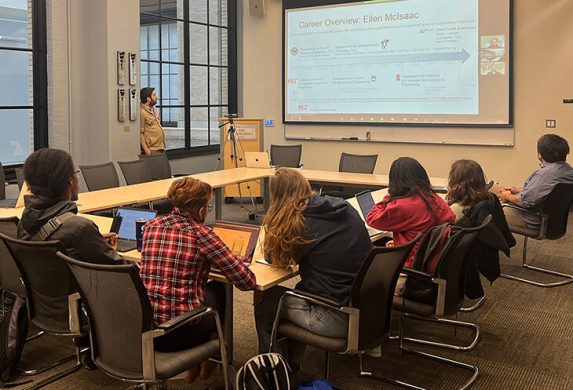
Last month, DMSE’s Mechanics of Materials became Mechanics of Real Life.
The class, 3.013, taught by Professor Cem Tasan, hosted an alumni career panel, with DMSE alums detailing ways they use the mechanics knowledge they learned as students in their engineering careers. “It was a great opportunity for students to hear about some of the diverse materials our alumni work on, and the interesting problems they solve,” Tasan said.
The panel was sponsored by the FORGE Initiative, the department’s program for alumni relations and professional development.
The first alum to present was Ellen McIsaac, SB ’12. A technical program manager at Lockheed Martin in Palmdale, California, McIsaac leads a research portfolio focused on high-temperature technologies.
Her career experience has spanned structures engineering, materials engineering, people management, and program management. During her time in DMSE, McIsaac was a researcher in Professor Silvija Gradecak’s research lab through MIT’s Undergraduate Research Opportunities Program (UROP), a teaching assistant for 3.091 (Solid-State Chemistry), and a member of the Society of Women Engineers as well as various student government groups.
McIsaac recounted the most important lessons she learned at MIT: staying confident and not panicking; how to solve challenging, open-ended problems; and understanding materials science basics. She also discussed how she’s applied mechanics of materials knowledge at her work through performing structural analysis, building new materials, and developing manufacturing processes.
Next on the panel was David Wang, SB ’19. Wang is a senior materials engineer at Carbon, a 3D-printing technology company in the San Francisco Bay Area. As a member of the materials team, he’s responsible for developing and scaling the production of new photo-curable polymers. In DMSE, he was an executive committee member in the Society of Undergraduate Materials Scientists, or SUMS; a teaching assistant for 3.012 (Fundamentals of Materials Science and Engineering) and 3.091; and a UROP researcher in Professor Yet-Ming Chiang’s lab.
An example of a product Carbon develops for clients is sneakers, for sportwear manufacturer Adidas, Wang said—the company 3-D prints the soles for Adidas 4-D shoes. He discussed how client needs can influence engineering and business decisions and how engineers at Carbon use topics in mechanics like stress-strain curves to evaluate the materials they develop.
After the presentations, students asked for advice on applying to graduate school, finding a workplace that’s a good fit, and about the panelists’ favorite types of materials.
“I think this was great,” Tasan said. “It was an excellent opportunity for our students to get a glimpse of how what you learn in class connects to what you do day-to-day as an engineer.” As the panel went to the end of class, Tasan aired his only regret: “I wish we had double the time.”
McIssac said she was happy to give students career guidance. “I thought back to some of my classes at MIT and realized that although I did tons of math and derivations, I didn’t always understand how things were applied to real-life applications.”